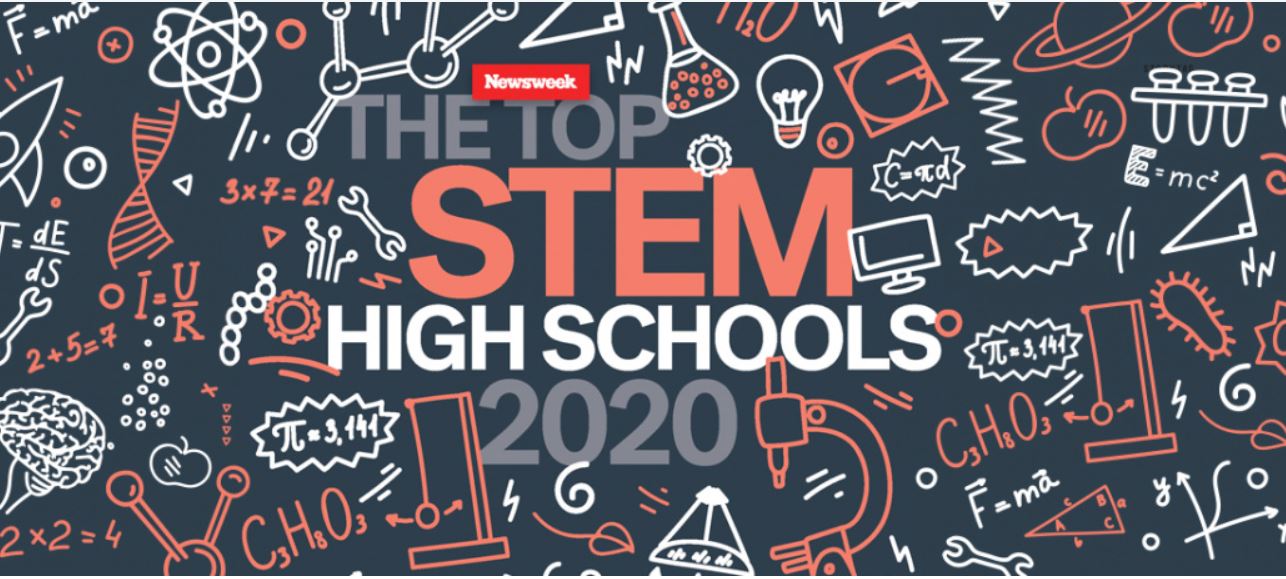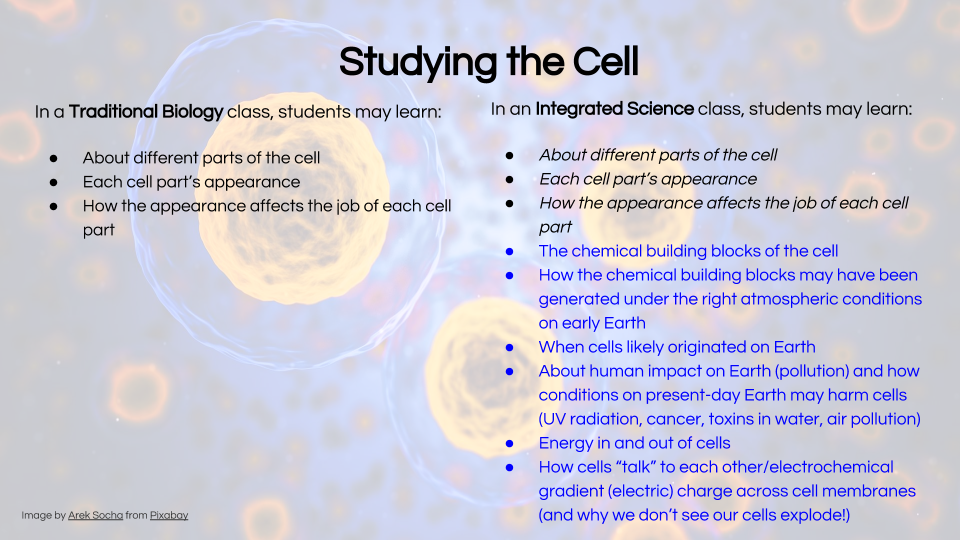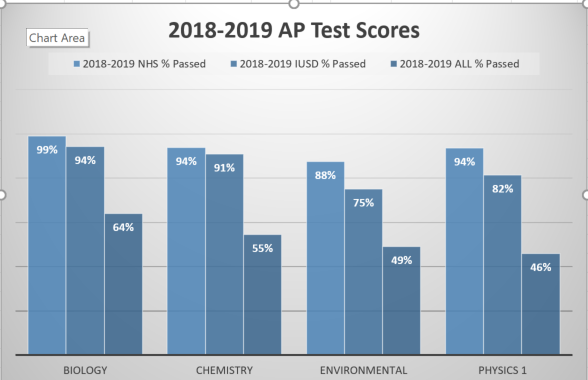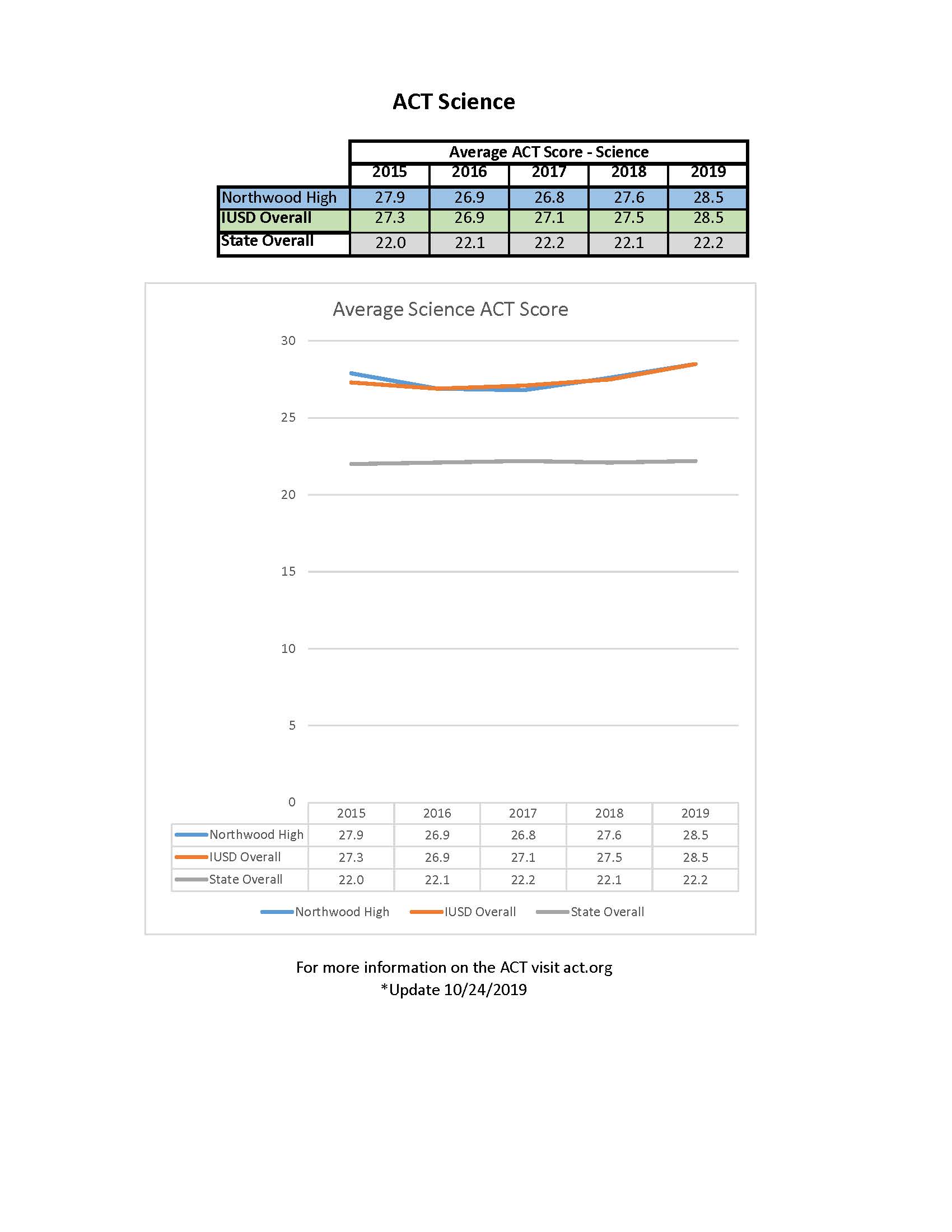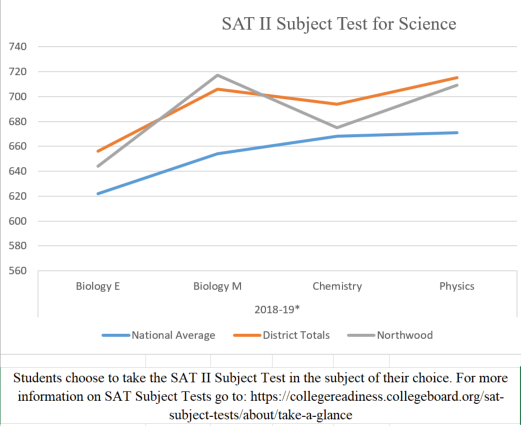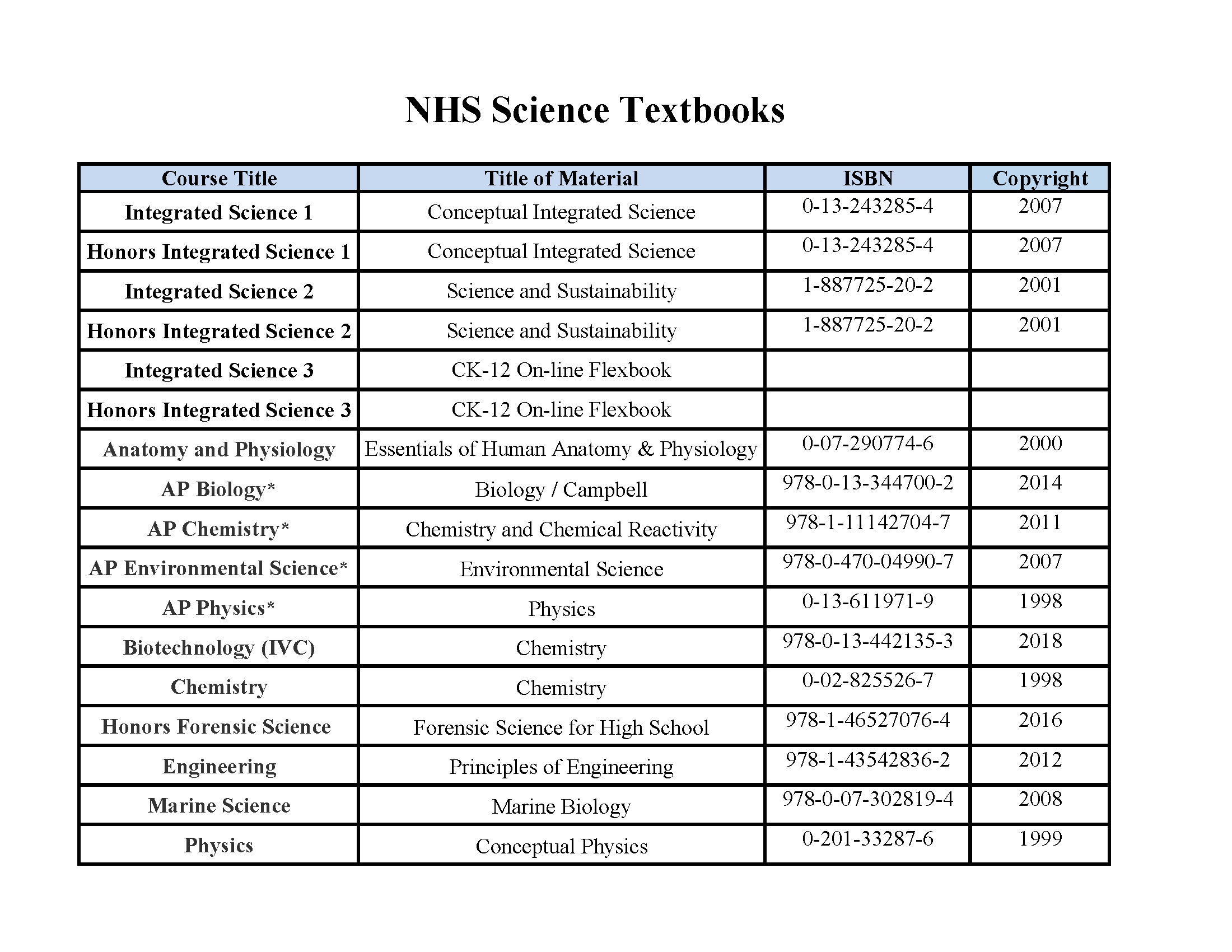NHS Science Program Overview
"Northwood High School intentionally began its science program nearly 20 years ago utilizing an integrated science model. This pedagogy was implemented, in large part, due to the American Association for Advancement of Science’s Project 2061. Their 1989 publication, Science for All Americans, addressed the question of what would be most important for the next generation of students to know and be able to do in science and technology. In other words, what would make students 'science literate.' There was a recognition then, as there is today, that science does not work alone in silos and isolation, but rather, across disciplines. This is important; this is how the real world works.
The Next Generation Science Standards were created using that same document. These standards represented a huge shift in how schools approach and deliver science education. We are no longer teaching science content in isolation. The new standards emphasize core ideas in life, physical, earth and space science, as well as cross-cutting concepts and engineering. The cross-cutting concepts openly represent the essence of integration. Major universities have responded in kind with integrated science courses, including U.C. Berkeley and Stanford.
In 2016, the IUSD NGSS Implementation Committee convened and agreed that we could not accomplish teaching all standards in just two years. With this in mind, our conclusion, as well as that of a national committee on NGSS, was that a three-year integrated science model was best for our students.
Additionally, integrated science began as a shift in instructional practice. Integrated science uses both a constructivist and an inquiry-based approach to instruction. These approaches recognize that students have mental models (pre-conceptions) that are often times incorrect. Instead of just disseminating more information for students to memorize, these instructional practices push students to confront their mental models and alter them as they explore new science concepts.
Northwood was founded in the spirit of making connections across disciplines, represented in our Integrated Science program and in our Humanities Core program. We believe that this spirit represents how the world operates and that the mode of siloed thinking actually hinders a student’s potential in the global economy. So in order to compete in and contribute to the world marketplace, we need students to be 'systems thinkers.' We need them to be science literate."
Mickey Dickson, Science Department Chairperson
NHS Course Progression

Northwood students take Integrated Science 1/Honors Integrated Science 1 and Integrated Science 2/Honors Integrated Science 2 in ninth and tenth grades, respectively. And while Integrated Science 3/Honors Integrated Science 3 is optional in eleventh grade for students, the course is strongly recommended for students to learn ALL the science standards (Biology, Chemistry, Physics, Earth and Space Science). Students in grades 11 and 12 have an opportunity to take the following courses as electives based on pre-requisites and availability:
- Integrated Science 3 / Honors Integrated Science 3*
- Advanced Horticulture
- Anatomy and Physiology
- AP Biology*
- AP Chemistry*
- AP Environmental Science*
- AP Physics*
- Biotechnology (IVC)
- Geology
- Honors Forensic Science (as part of the Forensics program)*
- Honors Interdisciplinary Climate Exploration
- Horticulture
- Principles of Engineering
- Marine Science
Advanced Placement (AP) and Honors courses denoted with an asterisk receive an extra grade point.
What is Integrated Science at nhs?
“If we teach only the findings and products of science—no matter how useful and even inspiring they may be—without communicating its critical method, how can the average person possibly distinguish science from pseudoscience?” (Sagan, 1996, p. 21)
In a fully integrated science course, the five disciplines of science and engineering (Biology, Chemistry, Physics, Earth, and Space science) are taught within units of instruction with ties to overarching local phenomena and storylines relevant to students’ lives. The integrated course model referred by some as the Every Science, Every Year model is offered at Northwood and referred to as Integrated Science. Each level of the model is themed and intended to ensure that students will learn content from each discipline of science and have those concepts continually reinforced. The themes of the course sequence are evolution (Integrated Science 1), energy (Integrated Science 2), and sustainability (Integrated Science 3).
The California Science Framework speaks specifically to the intent of integrated science, which “is to use disciplinary core ideas (DCIs), science and engineering practices (SEPs), and crosscutting concepts (CCCs) to coordinate and blend biology, chemistry, physics and geoscience into a unified science curriculum that promotes the development and application of reasoning skills and concepts within, between, and beyond traditional curricular boundaries; this is intended to promote the development of transferable reasoning skills that can be used throughout life” (California Department of Education, 2018, p. 1735).
The National Research Council (NRC) (2012), which designed the new Framework for K-12 Science Education, characterizes the integration of content as “science education in which students’ experiences over multiple years foster progressively deeper understandings of science” (p.217). To illustrate the difference between a traditional science class and an integrated science class, please refer to the following example.
IUSD, all high schools offer integrated science and are expected to cover the same Performance Expectations (PEs) which outline what students should be able to do by the end of instruction. These expectations determine the learning goals for the students and are consistent for all IUSD high schools. To learn more about the PEs, here is a detailed explanation of the expectations by topic. Here is a quick look at how the expectations are grouped:
|
Physical Science |
Life Science |
Earth & Space Sciences |
Engineering, Technology, and Applications of Science |
|
Structure & Properties of Matter |
Structure & Function |
Space Systems |
Engineering Design |
|
Chemical Reactions |
Matter & Energy in Organisms & Ecosystems |
History of Earth |
|
|
Forces & Interactions |
Interdependent Relationships in Ecosystems |
Earth's Systems |
|
|
Energy |
Inheritances & Variation of Traits |
Weather & Climate |
|
|
Waves & Electromagnetic Radiation |
Natural Selection & Evolution |
Human Sustainability |
|
Resources:
- Integrated science teaching helps students develop critical thinking skills
- Transitioning from Scientific Inquiry to Three-Dimensional Teaching and Learning
California Department of Education. (2018). 2016 Science Framework: Appendix 4. Retrieved from https://www.cde.ca.gov/ci/sc/cf/documents/scifwappendix4.pdf.
National Research Council. 2012. A Framework for K-12 Science Education: Practices, Crosscutting Concepts, and Core Ideas. Washington, DC: The National Academies Press. https://doi.org/10.17226/13165.
Next Generation Science Standards
For an overview of Next Generation Science Standards, please watch this short video clip.
"The focus on a few Disciplinary Core Ideas is a key aspect of a coherent science education. The Framework for K-12 Science Education identified a basic set of core ideas that are meant to be understood by the time a student completes high school:
To develop a thorough understanding of scientific explanations of the world, students need sustained opportunities to work with and develop the underlying ideas and to appreciate those ideas’ interconnections over a period of years rather than weeks or months. This sense of development has been conceptualized in the idea of learning progressions. If mastery of a core idea in a science discipline is the ultimate educational destination, then well-designed learning progressions provide a map of the routes that can be taken to reach that destination. Such progressions describe both how students’ understanding of the idea matures over time and the instructional supports and experiences that are needed for them to make progress.”
A Framework for K-12 Science Education: Practices, crosscutting concepts, and core ideas. (p. 26). Washington, DC: The National Academies Press. Retrieved from http://www.nap.edu/catalog.php?record_id=13165
IUSD NGSS Implementation Process
In 2016, an IUSD NGSS Implementation Committee was formed and comprised of 150 parents, students, community members, university faculty in science and education, university admissions representatives, elementary, middle and high school science teachers and counselors, and site and district administrators. The purpose of this committee was to determine which science course progressions would best prepare Irvine students for college, career, and citizenship and ensure that all students could access and learn all standards.
The committee worked to identify mutual interests, to build understanding of viable course design options, to evaluate course designs against the mutual interests, and discuss whether choosing different HS course designs would meet the mutual interests. A smaller sub-committee of the implementation group, called the NGSS Development Committee, was an expert group comprised of 42 elementary, middle and high school science teachers, who worked to design and evaluate course progressions, through an instructional lens. Both committees met regularly from January through the end of May in 2016 and a presentation of their work can be viewed here.
Northwood’s current model was adopted because of the school’s philosophy. A fundamental premise of Northwood High School from its inception was designing an interdisciplinary approach to instruction that dissolved the walls between disciplines and helped students to make powerful connections between the classroom and the world. That premise is alive in the integrated sciences, humanities core, and the forensics core. These thoughtfully designed programs are highly regarded by colleges and universities, and have resulted in admissions for Northwood High School graduates into very competitive schools.
How Do NHS Students Compare?
Below is comparison data for NHS students. This data was selected as an indication of NHS students' performance in the area of science. Click on the images below to see more specific information.
What Does I.S. Mean For College/University?
Colleges and universities rely on the school profile to determine what the school articulates as its most rigorous course of study and in determining whether students have availed themselves of the most rigorous coursework. If the school offers an integrated pathway, that is the pathway that students will be expected to take.
Admissions officers consider how the students perform in the courses offered at their school. For example, if the school determines AP/Honors course work shall be offered to juniors and seniors only, students are not penalized, because they are following the most rigorous course of study available to them. Upper-level Honors and AP courses receive the same weighted grade point. These courses are available to Northwood students in their junior and senior years.
When asked how Integrated Science courses should be treated, the California State University (CSU) system 2019-20 Admission Handbook stated: “CSU will require students to complete one life science and one physical science course, selected from the UC “a-g” list. The UC list of certified courses should indicate whether the integrated course is predominantly a biological or physical science course. If it is not indicated, two years of Integrated Science will meet the requirement or an Integrated Science course may fulfill either one year of a life science or physical science.”
The University of California (UC) system responded similarly in the A-G Policy Resource Guide: “Two years of college-preparatory science, including or integrating topics that provide fundamental knowledge in two of these three subjects: biology, chemistry, or physics. One year of approved interdisciplinary or earth and space sciences coursework can meet one year of the requirement. Computer Science, Engineering, Applied Science courses can be used in area D as an additional science (i.e., third year and beyond).”
Resources For Students
Our science textbooks are listed below. Integrated Science textbooks are not currently available for adoption but IUSD has plans to adopt materials in fall 2021. Integrated Science students have access to resources through their Canvas page where teachers have posted unit calendars which contain classwork, homework, presentations, handouts, additional resources, etc. for students to access outside of class 24/7.
Additional instructional resources:
- Argument-Driven Inquiry (ADI)
- Paper (Free Tutoring)
- Integrated Science 1 & 2 (Honors and College Prep)
- Process-Oriented Guided Learning Inquiry (POGIL)
